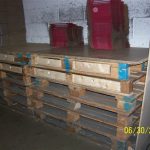We may receive a commission when you use our affiliate links. However, this does not impact our recommendations.
As Glen Huey and I work on the drawings for our forthcoming book on early furniture from the American South, we keep having a similar conversation. We spent some time at both the Museum of Early Southern Decorative Arts, and Old Salem Village in Winston-Salem, N.C. We shared time (and good Southern food) with guys who’ve been living with and recreating this furniture for years. We’re doing the drawings back here in Cincinnati, working from photographs and notes. The conversation we keep repeating goes something like this:
What does that look like to you?
Why do you think the guy who made this went to that much trouble?
Especially when he did this the easy way on the other part of the piece.
Would you have done it that way?
Probably not, but the way this guy did it has done just fine for 200 years.
I once heard Roy Underhill say “we did a lot better when we gave up trying to improve the 18th century.” Like a lot of woodworkers, I’m also a history geek. It’s tempting to adapt details to fit the way I would make it, or the way I was taught to make it, but that’s not what this book is about. It’s a record of how cabinetmakers in Early America really did things. When the book is published, I expect to receive a letter or two from someone telling me that it’s just plain wrong to nail on a drawer bottom from below. It may be against the rules, but we have several examples of that method working for a couple of centuries.
Here is a link to our first blog post about this project, including a slide show of pieces we considered for inclusion.
Here are some supplies and tools we find essential in our everyday work around the shop. We may receive a commission from sales referred by our links; however, we have carefully selected these products for their usefulness and quality.












Old southern cabinetmakers weren’t the only ones to nail drawer bottoms on – old Japanese tansu-makers did the same, except that they used wooden pegs as nails, probably “drilling” holes for them with one of the long square-tipped gimlets that is spun between the user’s palms, which can be found on the Hida Tool website (hidatool.com) in the Bamboo section. And no, the pegs weren’t bamboo as many assume, because that would spell disaster for the blade of a plane used to trim the drawer bottom smooth. Find more in the Heinekens’ book Tansu if interested. The pegs weren’t always a permanent fastening, though, because it’s not uncommon to find ones now in which small nails have been added.
This book makes me think of a visit to Mount Vernon three years ago. While checking out the furniture, it became clear that my folks had three reproductions ( probably from the 50’s) of pieces in Mount Vernon. I’m lucky to still have these and plan to restore them soon. Only minor cosmetics and a few straight forward repairs are needed.
I’ve looked for some time for a book that might be dedicated to the furniture in Mount Vernon. Any suggestions?
It seems every other aspect of George Washington’s life and possessions is thoroughly covered, almost to a fault.
Thanks
John O
I can’t wait for this book. Furniture books and magazines have focused on New England and Shaker furniture for so long, it’s easy to forget that southerners also needed objects to sit down on, and eat at, and to store clothing in.
Looking forward to reading this book.
And, I had a thought on nailing drawer bottoms from below. Based on how we’ve been “taught” to do things it doesn’t seem right. But getting past dogmatic narrow-mindedness, it’s easy to see why it would work. I’m assuming that the carpenter used cut nails and we know how well cut nails hold in wood. And, nails also allow wood a little room to move with seasonal expansion where a glued joint might want to split the drawer bottom. If that drawer bottom is still attached after 200 years, I’d say it’s a valid technique. It’s also much faster than cutting grooves in the drawer sides or fashioning drawer slips. = )
regards,
Dave
That is a book I’m really looking forward to getting my hands on. You guys hurry up every chance you get.
I think that as hobbyist we tend to look at the life of former cabinet makers with rose tinted glasses. Something along the line of “boy wouldn’t it be great to spend all day every day in the shop” thought process. We forget that time was money to them then as it is now. I’m sure sometimes they had to just get product out the door. Also, our ancestors weren’t dummies. (Well, not ALL of them anyway.) They might have known that their so called tricks and shortcuts would hold up just fine.